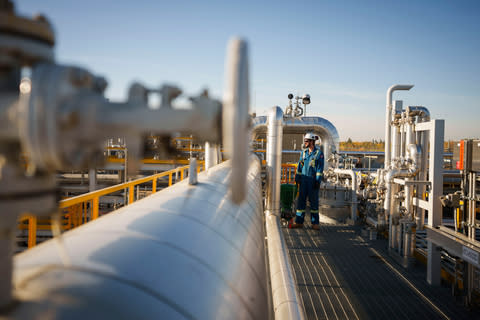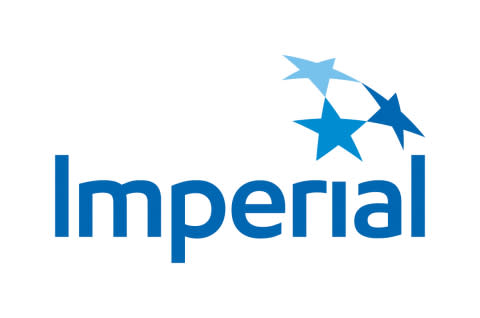Imperial achieves first oil production from Grand Rapids project using lower emission technology


Ramping up production to achieve 15,000 barrels per day of GHG-advantaged volumes
Expected to reduce emissions intensity up to 40%, compared to existing technologies
Supports company goal to reduce operated oil sands emissions intensity 30% by 2030
CALGARY, Alberta, May 22, 2024--(BUSINESS WIRE)--Imperial (TSE: IMO, NYSE American: IMO) today announced its Grand Rapids oil sands project has started production at Cold Lake, marking the first commercial deployment of the recovery technology that uses less steam to lower emissions intensity.
The project, located at Imperial’s Cold Lake operating site, is expected to reduce greenhouse gas emissions intensity by up to 40 percent compared to existing processes in use. The technology, known as solvent-assisted, steam-assisted gravity drainage, or SA-SAGD, uses a lighter oil mixed with steam to recover the oil from underground deposits. Imperial developed and piloted the technology, which is the first deployment in industry.
"Grand Rapids represents a key milestone in Imperial’s plans to continue to lower emissions and deliver value for shareholders through high-value opportunities that continue to grow production and reduce costs," said Brad Corson, chairman, president and chief executive officer.
"At Cold Lake, we are working to transition approximately 40 percent of production to lower emission technology by 2030. I want to commend the teams that have safely brought this project to production more than a year ahead of the original schedule."
Production will continue to ramp up over the next few months to achieve full rates of 15,000 gross barrels per day later this year.
Imperial is planning reductions in greenhouse gas emissions intensity over the next decade to help support Canada’s net zero goals. By the end of 2030, Imperial anticipates reduced Scope 1 and 2 greenhouse gas emissions intensity of its operated oil sands facilities by 30 percent, compared with 2016 levels. The company plans to achieve this through implementation of lower greenhouse gas next generation technologies at its Cold Lake operation, efficiency improvements at its facilities and the use of carbon capture and storage.
Forward-looking statements: Statements of future events or conditions in this report, including projections, targets, expectations, estimates, and business plans, are forward-looking statements. Forward-looking statements include references to Imperial’s greenhouse gas emissions intensity goal for 2030 for its oil sands operations; the impact and timing of the Cold Lake Grand Rapids project, including the timing of production ramp-up, expected production, and reductions to greenhouse gas emissions intensity; and the company’s plans to transition Cold Lake production to lower emission technology, to achieve efficiency improvements and use carbon capture and storage, and to continue to lower emissions and pursue opportunities to grow production and reduce costs, and are based on the company's current expectations, estimates, projections and assumptions at the time the statements are made.
Actual future financial and operating results, including expectations and assumptions concerning future energy demand, supply and mix; project plans, timing, costs, technical evaluations and capacities, and the company’s ability to effectively execute on these plans and operate its assets, including the Cold Lake Grand Rapids Phase 1 project; the adoption and impact of new facilities or technologies on reductions to greenhouse gas emissions, including but not limited to technologies using solvents to replace energy intensive steam at Cold Lake, boiler flue gas technology at Kearl, Strathcona renewable diesel, carbon capture and storage, recovery technologies and efficiency projects, and any changes in the scope, terms, or costs of such projects; that any required support from policymakers and other stakeholders for various new technologies will be provided; the availability and cost of locally-sourced and grown feedstock and the supply of renewable diesel to British Columbia in connection with its low-carbon fuel legislation; the amount and timing of emissions reductions, including the impact of lower carbon fuels; the results of research programs and new technologies, including with respect to greenhouse gas emissions, and the ability to bring new technologies to scale on a commercially competitive basis, and the competitiveness of alternative energy and other emission reduction technologies; the receipt, in a timely manner, of regulatory and third-party approvals, including for new technologies that will help the company meet its lower emissions goals; performance of third-party service providers; commodity prices, foreign exchange rates and general market conditions; and applicable laws and government policies, including with respect to climate change, greenhouse gas emissions reductions and low carbon fuels, could differ materially depending on a number of factors.
These factors include global, regional or local changes in supply and demand for oil, natural gas, petroleum and petrochemical products and resulting demand, price, differential and margin impacts, including foreign government action with respect to supply levels and prices, and the occurrence of wars; political or regulatory events, including changes in law or government policy; environmental regulation, including climate change and greenhouse gas regulation and changes to such regulation; failure, delay or uncertainty regarding supportive policy and market development for the adoption of emerging lower emission energy technologies and other technologies that support emissions reductions; receipt of regulatory approvals in a timely manner, especially with respect to large scale emissions reduction projects; project management and schedules and timely completion of projects; unanticipated technical or operational difficulties; project management and schedules and timely completion of projects; availability and performance of third-party service providers; and other factors discussed in Item 1A Risk factors and Item 7 Management’s discussion and analysis in the company’s most recent annual report on Form 10-K.
Forward-looking statements are not guarantees of future performance and involve a number of risks and uncertainties, some that are similar to other oil and gas companies and some that are unique to Imperial. Imperial’s actual results may differ materially from those expressed or implied by its forward-looking statements and readers are cautioned not to place undue reliance on them. Imperial undertakes no obligation to update any forward-looking statements contained herein, except as required by applicable law.
Forward-looking and other statements regarding Imperial's environmental, social and other sustainability efforts and aspirations are not an indication that these statements are material to investors or require disclosure in the company's filings with securities regulators. In addition, historical, current and forward-looking environmental, social and sustainability-related statements may be based on standards for measuring progress that are still developing, internal controls and processes that continue to evolve, and assumptions that are subject to change in the future, including future rule-making. Individual projects or opportunities may advance based on a number of factors, including availability of supportive policy, technology for cost-effective abatement, company planning process, and alignment with Imperial’s partners and other stakeholders.
Source: Imperial
After more than a century, Imperial continues to be an industry leader in applying technology and innovation to responsibly develop Canada’s energy resources. As Canada’s largest petroleum refiner, a major producer of crude oil, a key petrochemical producer and a leading fuels marketer from coast to coast, our company remains committed to high standards across all areas of our business.
View source version on businesswire.com: https://www.businesswire.com/news/home/20240522998144/en/
Contacts
Investor relations
(587) 476-4743
Media relations
(587) 476-7010

 Yahoo Finance
Yahoo Finance 